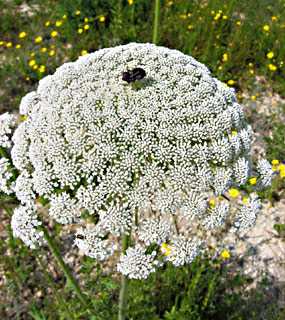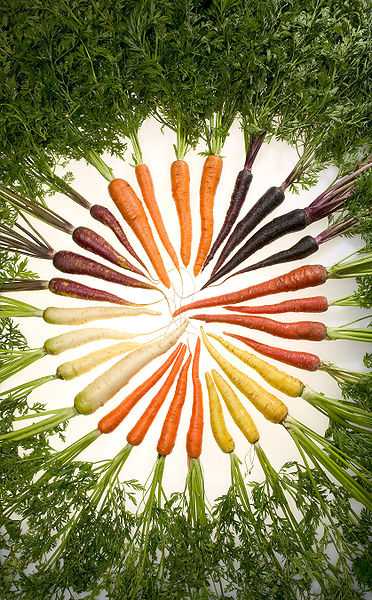You ask, “What is life?” That is the same as asking, “What is a carrot?” A carrot is a carrot and we know nothing more.
– Anton Chekhov in a letter to his beloved wife, Olga Knipper Chekhov (April 20, 1904)
It’s been in your boxes for weeks now, our lovely and wintry carrot—steady, loyal, and pledging continuity and security. True, the carrot’s been around for quite awhile, but in the beginning its taste was still mediocre. It’s never been thrilled by warm weather, thus the beginning-of-the-season carrots are always just so-so. But now it has reached its peak: sweet, juicy and heartwarming. This week’s newsletter is a tribute to The Carrot.
Genealogy first: the carrot (Daucus carota) belongs to the Umbelliferae family, which includes such vegetables and spices as celery, parsley, fennel, dill and cilantro. Various wild carrot species have grown in many areas in the world, specifically in the Mediterranean, south Asia, Africa, Australia and America.
The origin of certain domesticated species is probably Afghanistan and Turkey. The Arabs introduced the carrot to Spain, where it spread to Europe. The first domesticated types came in a variety of colors: red, purple and yellow-green. Later, yellow and white carrots were developed in the 18th century. The Dutch grew orange carrots, which are today’s most common variety. In Israel, the carrot has been harvested from the beginning of the Jewish settlement. The Arabs used to grow dark purple carrots, which can still be found today, to a small extent.
The wild carrot is known in English as “Queen Anne’s lace,” whose name originated in a fairy tale about how the wild carrot’s flower got its unique look: a sort of white lace embroidery, with a dark red-purple dot at its center. Queen Anne, wife of King James the First who served as Denmark’s queen in the 16th and 17th centuries, was an experienced lace tatter. One day she pricked her finger while sewing, and a drop of blood rolled onto the center, creating this special flower. Although the tale only appeared in writing some 200 years after Anne’s death, it could be associated with the 17th century custom for ladies to smartly adorn their hats with wild carrot flowers.
Carrots are biennial. At the end of their first year of growth, they develop leaves and a root. When the root is well-developed and the plant has received its necessary dosage of cold weather, the next season leads to the development of a stem which grows rather tall. When the stem branches out, it produces peripheral branches which end in an inflorescence resembling an umbrella. The seeds remain in the dry fruit, one seed per fruit. They contain ethereal oil which provides their unique scent. When a carrot is grown for food, we are interested in its taproot, which is why it should be picked before reaching flowering and seeding – for by then the root is too old and becomes grainy.
The root develops in three stages: at the first stage, right after sprouting, a long skewer-like root grows. At the second stage, the root thickens and becomes longer, receiving its orange color. At the third stage, the downward growth stops and the root only thickens. The root consists of a central stele, the endodermis and the cortex. The endodermis is surrounded by tissue, which creates the inner cortex and the outer phloem. This tissue is rich with color substance and sugars. A carrot’s quality is determined by the thin texture of its central stele in comparison to the cortex tissues. In difficult growing conditions, or as the plant ages, the central stele becomes wood-like and the carrot is no longer fit for human consumption.
The carrot appearing in your boxes was seeded three to four months ago. Never one to rush, the carrot sprouted slowly. In the beginning, two long ears, the cotyledons, peeked out of the earth. Afterwards the plant actually grew “real leaves,” the type we can identify as carrot leaves and which bring joy and delight to every bunny. The carrot needs a lot of space to breathe and grow, both lengthwise and depth-wise and preferably from all four directions. But its seeds are tiny and hard to seed accurately and well-spaced. As soon as it begins to grow, we start thinning the plants and pluck out lots of tiny carrot sprouts to allow the remainder to grow nice, bountiful roots
And though we have learned by now to avoid being merciful and stingy in the thinning- out field, it’s so hard to thin out those plants. We take pity on up-and-coming carrots and do a superficial thinning. But then we’re forced to come back at a later stage to “really” thin the carrot beds, regardless. Actually the earlier carrot harvest can also be considered thinning, since we do not pick the whole bed. Instead we attempt to pick only certain carrots from the crop, giving some well-needed living and breathing space to the remaining residents of the bed.
The orange of the carrot is known for its medicinal attributes: research has granted it high acclaim as a cancer fighter and in battling heart diseases. Carrots maintain healthy eyes, strengthen the immune system, protect your skin, and generally boost human growth and vitality. Its healing powers come from the yellow-orange caratanoid pigment group: the alpha carotene, beta carotene and beta-cryptoxanthin. In Chinese medicine, carrots are known to strengthen the spleen and blood in anemia. Medical research supports this too, realizing that vitamin A (whose source is in beta carotene) is beneficial in absorbing iron and relieving the symptoms of anemia.
Despite the orange beta carotene, carrots don’t only come in orange. Look at this picture of carrots in rainbow colors. How beautiful are they?
Overdosing on carrots may cause carotenemia– a temporary yellowing of the skin, caused by excess consumption of beta carotene from fresh carrots. This is not dangerous, only a little strange looking, and it disappears several weeks after going cold turkey on beta carotene.
_______________________________________
Carrot Tips
– To store carrots, remove the green leaves, otherwise they will draw water from the root and cause it to shrivel.
– Carrots should be stored in the coldest place in the refrigerator, in a plastic bag or in the vegetable drawer.
– The carrot is best unpeeled. You can lightly scrape the peeling, or not at all. The peeling is tasty and nutritious.
– Like the tomato, a cooked carrot is more nutritious and healthier than a raw carrot. The level of vitamin A rises as the cooking breaks down the cell walls. It is best to cook carrots in a small amount of water, so the vitamins are not dissipated in the cooking liquid.
– Adding a small amount of oil to the cooking liquid will increase the absorption of antioxidants.
– It is recommended to combine carrots with foods containing vitamin E, like peanuts, pumpkins, leafy vegetables and whole grains.
*********
Welcome back, good rain from last week. Here’s hoping for continued plentiful rains, a not-so-terrible storm, and a blessed and good winter to us all!
Alon, Bat Ami, Dror, Maya and the Chubeza team
_______________________________________________
WHAT’S IN THIS WEEK’S BOXES?
Monday: Pumpkin/carrots, scallions/leeks, spinach/Swiss chard/kale, tomatoes, daikon/radishes, cauliflower, parsley, cucumbers, lettuce, beets/turnips/fennel. Small boxes only: broccoli
Large box, in addition: Arugula/“baby” greens, garden peas/Jerusalem artichoke, celery/celeriac, cabbage
Wednesday: Slice of pumpkin/carrots, leek/scallions/green garlic, spinach/Swiss chard/kale, tomatoes, small radishes/daikon/turnip, green or red cabbage, parsley, cucumbers, broccoli/cauliflower, lettuce, beet/fennel
Large box, in addition: Mixed baby greens/arugula, snow peas/Jerusalem artichoke, celery/celriac
And there’s more! You can add to your basket a wide, delectable range of additional products from fine small producers: flour, fruits, honey, dates, almonds, garbanzo beans, crackers, probiotic foods, dried fruits and leathers, olive oil, bakery products, pomegranate juice and goat dairy too! You can learn more about each producer on the Chubeza website. On our order system there’s a detailed listing of the products and their cost, you can make an order online now!


